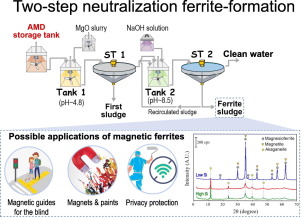当前位置:
X-MOL 学术
›
Sci. Total Environ.
›
论文详情
Our official English website, www.x-mol.net, welcomes your
feedback! (Note: you will need to create a separate account there.)
The two-step neutralization ferrite-formation process for sustainable acid mine drainage treatment: Removal of copper, zinc and arsenic, and the influence of coexisting ions on ferritization.
Science of the Total Environment ( IF 8.2 ) Pub Date : 2020-01-23 , DOI: 10.1016/j.scitotenv.2020.136877 Toshifumi Igarashi 1 , Pepe Salgado Herrera 2 , Hiroyuki Uchiyama 3 , Hiroko Miyamae 4 , Nobuyoshi Iyatomi 5 , Koichi Hashimoto 6 , Carlito Baltazar Tabelin 7
Science of the Total Environment ( IF 8.2 ) Pub Date : 2020-01-23 , DOI: 10.1016/j.scitotenv.2020.136877 Toshifumi Igarashi 1 , Pepe Salgado Herrera 2 , Hiroyuki Uchiyama 3 , Hiroko Miyamae 4 , Nobuyoshi Iyatomi 5 , Koichi Hashimoto 6 , Carlito Baltazar Tabelin 7
Affiliation

|
Acid mine drainage (AMD) or acid rock drainage (ARD), the most notorious environmental problem in many mines and underground construction sites, is generally managed using lime neutralization. This approach is effective but unsustainable in the long term, so we introduced the two-step neutralization ferrite-formation process in our previous works as an alternative. However, several important issues related to this new approach-the partitioning of hazardous elements during treatment, stability of generated sludges, and influence of coexisting ions-remains unclear. In this study, real AMD containing zinc (Zn), copper (Cu) and arsenic (As) was treated using a laboratory-type continuous ferrite process flow setup. Partitioning of hazardous elements in the two sludges was elucidated by X-ray fluorescence spectroscopy (XRF) and X-ray absorption spectroscopy (XAS) while the stability of sludges was determined by standard leaching experiments. The bulk of Cu and As species (both As(III) and As(V) based on XANES spectra) were partitioned in the first sludge while ~64% of Zn was associated with the ferrite sludge. In terms of stability, both sludges were relatively inert and released only minute amounts of Zn, Cu and As, all of which were below the Japanese environmental standards. The roles played by two of the most ubiquitous coexisting ions in AMD on ferritization-dissolved silica (Si) and aluminum ion (Al3+)-were also elucidated using 10 synthetic AMDs. Between the two, dissolved Si exhibited stronger adverse effects on ferritization than Al3+. At dissolved Si above 4 mg/L, Si-O-Fe surface complex formation on amorphous Fe-precipitates or Fe-oxide precursor minerals became extensive, which protected these phases from the dissolution-transformation reactions required to form strongly magnetic magnesioferrite and magnetite. These results suggest that the flexibility and applicability of this new AMD treatment approach could be improved by controlling the dissolved Si concentration prior to the ferrite formation step.
中文翻译:

分两步进行的中和铁素体形成过程可进行可持续的酸性矿山排水处理:去除铜,锌和砷,以及共存离子对铁素体的影响。
酸性矿山排水(AMD)或酸性岩矿排水(ARD)是许多矿山和地下建筑工地中最臭名昭著的环境问题,通常使用石灰中和法来解决。这种方法从长远来看是有效的,但长期不可持续,因此我们在以前的工作中介绍了两步中和铁氧体形成过程作为替代方法。但是,与这种新方法有关的几个重要问题,例如处理过程中有害元素的分配,产生的污泥的稳定性以及共存离子的影响,仍不清楚。在这项研究中,使用实验室类型的连续铁氧体工艺流程设置处理了包含锌(Zn),铜(Cu)和砷(As)的真正AMD。通过X射线荧光光谱(XRF)和X射线吸收光谱(XAS)阐明了两种污泥中有害元素的分配,同时通过标准浸出实验确定了污泥的稳定性。大量的铜和砷物质(基于XANES光谱的砷(III)和砷(V))在第一污泥中分配,而约64%的锌与铁氧体污泥相关。在稳定性方面,两种污泥均相对惰性,仅释放微量的Zn,Cu和As,所有这些含量均低于日本环境标准。还使用10种合成AMD阐明了AMD中两种最普遍存在的离子在铁素体溶解的二氧化硅(Si)和铝离子(Al3 +)上的作用。在这两者之间,溶解的Si对铁素体的不利影响比Al3 +强。在高于4 mg / L的溶解Si下,非晶态Fe沉淀物或Fe氧化物前体矿物上的Si-O-Fe表面复合物形成变得广泛,这保护了这些相免受形成强磁性菱铁矿和磁铁矿所需的溶解转变反应。这些结果表明,通过在铁素体形成步骤之前控制溶解的硅浓度,可以改善这种新的AMD处理方法的灵活性和适用性。
更新日期:2020-01-23
中文翻译:

分两步进行的中和铁素体形成过程可进行可持续的酸性矿山排水处理:去除铜,锌和砷,以及共存离子对铁素体的影响。
酸性矿山排水(AMD)或酸性岩矿排水(ARD)是许多矿山和地下建筑工地中最臭名昭著的环境问题,通常使用石灰中和法来解决。这种方法从长远来看是有效的,但长期不可持续,因此我们在以前的工作中介绍了两步中和铁氧体形成过程作为替代方法。但是,与这种新方法有关的几个重要问题,例如处理过程中有害元素的分配,产生的污泥的稳定性以及共存离子的影响,仍不清楚。在这项研究中,使用实验室类型的连续铁氧体工艺流程设置处理了包含锌(Zn),铜(Cu)和砷(As)的真正AMD。通过X射线荧光光谱(XRF)和X射线吸收光谱(XAS)阐明了两种污泥中有害元素的分配,同时通过标准浸出实验确定了污泥的稳定性。大量的铜和砷物质(基于XANES光谱的砷(III)和砷(V))在第一污泥中分配,而约64%的锌与铁氧体污泥相关。在稳定性方面,两种污泥均相对惰性,仅释放微量的Zn,Cu和As,所有这些含量均低于日本环境标准。还使用10种合成AMD阐明了AMD中两种最普遍存在的离子在铁素体溶解的二氧化硅(Si)和铝离子(Al3 +)上的作用。在这两者之间,溶解的Si对铁素体的不利影响比Al3 +强。在高于4 mg / L的溶解Si下,非晶态Fe沉淀物或Fe氧化物前体矿物上的Si-O-Fe表面复合物形成变得广泛,这保护了这些相免受形成强磁性菱铁矿和磁铁矿所需的溶解转变反应。这些结果表明,通过在铁素体形成步骤之前控制溶解的硅浓度,可以改善这种新的AMD处理方法的灵活性和适用性。











































 京公网安备 11010802027423号
京公网安备 11010802027423号